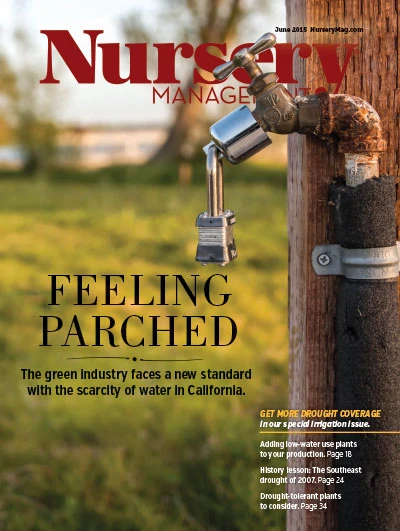 It was October 2007. The Piedmont of North Carolina was in the middle of the worst drought in 100 years. Yet walk by the hockey fields at either Duke University in Durham or the University of North Carolina in Chapel Hill, and you would see sprinklers on at full blast, watering AstroTurf. It was hockey season, and the International Hockey Federation requires college teams to saturate the synthetic turf before each practice and all games. According to the Hockey Federation, watering the AstroTurf before its use prevents injuries. Ahem, so does forgoing practice and games, but there would be none of that.
It was October 2007. The Piedmont of North Carolina was in the middle of the worst drought in 100 years. Yet walk by the hockey fields at either Duke University in Durham or the University of North Carolina in Chapel Hill, and you would see sprinklers on at full blast, watering AstroTurf. It was hockey season, and the International Hockey Federation requires college teams to saturate the synthetic turf before each practice and all games. According to the Hockey Federation, watering the AstroTurf before its use prevents injuries. Ahem, so does forgoing practice and games, but there would be none of that.
Meanwhile, just a few miles up the road, plants were dying at the JC Raulston Arboretum at North Carolina State University. Water restrictions put in place to deal with the drought conditions prohibited the organization from watering its world-renowned collection of plants.
Politics. It’s not a good topic in the best of times, but in times of stress, the topic can get downright divisive. JC Raulston’s staff wasn’t the only nursery facing tough water restrictions, and many were asking why the universities were allowed to water AstroTurf for practices that could have been cancelled or delayed, when living trees and shrubs were suffering. At this point in the horrendous drought of 2007, environmental advocates were not as concerned about college sports as they were about the environment. Plants play a vital role in home value, but even more important is the role plants play to cool the Earth and to produce oxygen. The environmental advocates could see that with the current policies in place, we were heading toward a modern day dust bowl. Politics, indeed.
Strange, new territory
The drought had a tremendous impact on gardening in general, from those who grew plants, to those who sold plants and those who purchased plants. Homeowners were discouraged, to say the least. Many believed gardening as they knew it had dried up, and they would never be able to garden like they used to. And some gardeners did give up. For a few, drought-tolerant plants became popular, particularly succulents. While succulents satisfied these gardeners for a while, they were only discouraged again once the rains returned.
In Raleigh, N.C., homeowners faced watering restrictions. It’s a sad season when residents hope for a hurricane, just for the rain. Homeowners were not allowed to wash their own cars, and Raleigh banned car washes except at facilities that were certified to use recycled water. Pools were not allowed to be filled or topped off. Since irrigation of residential lawns is one of the most visible and effective ways to conserve watering, outdoor watering was first restricted, then banned. The restrictions were step-wise, first allowing watering on alternate days, until finally there was no outside watering of any kind. Neighbors told on other neighbors. There were night-time inspections in hopes of catching the guy that wanted his grass to be green. Wells were installed, because that water use wasn’t restricted. The legal use of well-water didn’t set well with those on city water.
Homeowners needed to heal before investing, again, in the exterior of their property.
During the drought, Lake Lanier, a 38,000-acre reservoir in northern Georgia, dropped so low that parts of the lake bottom had become visible. Indelible images of the reservoir base had people comparing the sight to a moonscape. Panic set in, for sellers and buyers alike. By November of that year, there were only 79 days of water left. Crops failed. Nurseries and foresters lost millions.
An industry pays the price
 The 2007 drought took its toll on the nursery industry. The plants that survived just weren’t selling. Many businesses took hard losses, and several nurseries closed their doors. Even if businesses were able to overcome the severe drought, the weather following that dry season was just as unforgiving. A late and unpredicted frost combined with record heat in early June, with multiple days of temperatures at 100ºF or more, proved to be the last straw for some businesses. As the reservoirs were drying up, so were bank accounts of the businesses working hard to keep their doors open.
The 2007 drought took its toll on the nursery industry. The plants that survived just weren’t selling. Many businesses took hard losses, and several nurseries closed their doors. Even if businesses were able to overcome the severe drought, the weather following that dry season was just as unforgiving. A late and unpredicted frost combined with record heat in early June, with multiple days of temperatures at 100ºF or more, proved to be the last straw for some businesses. As the reservoirs were drying up, so were bank accounts of the businesses working hard to keep their doors open.
The effects of the 2007 drought and the weather patterns that followed were horrible. As the scientists discovered, in the South, droughts are cyclic. In Georgia, researchers looked at the 100-year soil and rainfall data from the Department of Geography. Through this research, they found that these periods of drought are part of what defines the Southeast. It might be comforting to know this, and be somewhat assured that it wasn’t completely man-made weather conditions. But knowing this doesn’t make the problem go away. The question is, armed with the knowledge that it can happen again, can we be better prepared next time?
For Mike Worthington of Worthington Farms, Greenville, N.C., the drought was a learning experience.
Worthington Farms operates a container and B&B nursery. Before 2004, it was able to use well water to supply the container operation. Then demand on the deep aquifers in the eastern part of the state began to exceed regeneration. The state of North Carolina instituted regulations that reduced the allowed withdrawals from the deep wells over time, forcing usage of surface-water sources.
“We constructed a surface water collection pond to reduce our dependence on well water,” says Worthington. “But by 2007, we had also increased our production, exceeding what our wells could service alone.The drought of 2007 nearly emptied our pond. Luckily, we were able to supplement surface water resources with existing wells. Our surface water was still declining due to usage and evaporation, but we were able to make it to the winter. Then we used our wells to recharge the surface water in preparation for the following summer.”
 Even with its own water sources, Worthington Farms suffered losses during the drought.
Even with its own water sources, Worthington Farms suffered losses during the drought.
“In the field, we lost our unirrigated plants,” he says. “What we were able to keep we hand-watered at great cost, keeping some drought-tolerant plants like crape myrtle and holly alive. We did have drip irrigation on some of our fields.”
To prepare for future droughts, Worthington developed more surface water storage options, adding more days of water storage.
“Before entering the nursery business, we were swine producers. We were able to secure some grant money to help us with the cost of emptying and cleaning the open pits used to store swine waste,” he says. “Over time we were able to re-grade the surrounding terrain to help these structures collect water. We added a pipeline from there to the existing production in case of an emergency.”
Chris McCorkle, director of operations of McCorkle Nurseries, shared that his company was able to survive the drought due to earlier planning and preparation.
“Historically, our business development centered on having enough water to sustain our growing operations,” McCorkle says. “As we grew, we found we didn’t have adequate groundwater to meet all of our irrigation needs. To achieve sufficient water availability, we developed our farms to reclaim the majority of all run-off in ponds.”
When 2007 came, McCorkle Nurseries was better prepared than many of its fellow nurseries.
“In April 2007 we had a deep freeze, followed by more than a year of drought. We refer to it as the ‘freeze-dried year,’” McCorkle says. “But with our ponds, we were able to survive what was likely the driest period in our company’s history.”
Worthington Farms and McCorkle Nurseries were some of the lucky ones that stayed in business.
Silver linings
While the economic impact of the drought was devastating to the nursery industry, there have been some positives to come out of the experience. Not only have nurseries taken steps to prepare for future droughts, including building ponds for water collections, but policy makers have taken a second look at what should be done during times of drought.
“From my viewpoint, our industry reacted well and was able to lobby lawmakers to reverse many total outdoor water use bans with a more balanced approach on rationing,” McCorkle says.
For those in the industry, the drought of 2007 won’t soon be forgotten. The industry learned some valuable lessons, but what about the homeowners?
Homeowners are buying plants, shrubs and trees once again. Either memories have faded, or they’re thinking enough is enough. Homeowners need to beautify their homes, and the knowledge that we might suffer another drought isn’t enough to stop them. With all the rain the Southeast has seen in recent years, the grass is greener than ever before, with little help from automatic irrigation, and gardens are growing lush and healthy.
The Southeast is currently in a rainfall cycle, and homeowners are back to their old ways of living and gardening, washing cars and watering lawns with abandon. Rain barrels, once a point of purchase at independent garden centers, are now free for the taking on Craig’s List.
But those of us in the industry know we can’t rest on our laurels, and that includes homeowners. One of the keys to preventing the economic setbacks the nursery industry suffered during the last drought is to educate homeowners about water-wise gardening. Landscapes should be designed with an approach capable of handling the Southeast and its feast-or-famine cycle. And homeowners need the plants for these landscapes to be available for purchase. Right plant, right place has never been more important. Education remains key to maintaining a healthy love of gardening and a thriving nursery industry, even while the memories of the drought of 2007 are quickly fading.
Editor’s note:We reached out to some nursery owners forced to close their operations after the drought, but no one was available for an interview.
Helen Yoest is an environmental engineer and owner of Gardening with Confidence in Raleigh, N.C.

Explore the June 2015 Issue
Check out more from this issue and find your next story to read.
Latest from Nursery Management
- The Growth Industry Episode 2: Emily Showalter on how Willoway Nurseries transformed its business
- AmericanHort urges exclusion of sphagnum peat moss from proposed Canadian tariff
- Farwest Show calls for 2025 New Varieties Showcase entries
- Oregon Nurseries Hall of Fame member Jack Bigej passes away
- Everde Growers files for Chapter 11 bankruptcy
- DCA Outdoor files for Chapter 11 bankruptcy
- February issue recap
- Giant steps





